How do I output colored text to the terminal in Python?
This somewhat depends on what platform you are on. The most common way to do this is by printing ANSI escape sequences. For a simple example, here's some Python code from the Blender build scripts:
class bcolors:
HEADER = '\033[95m'
OKBLUE = '\033[94m'
OKCYAN = '\033[96m'
OKGREEN = '\033[92m'
WARNING = '\033[93m'
FAIL = '\033[91m'
ENDC = '\033[0m'
BOLD = '\033[1m'
UNDERLINE = '\033[4m'
To use code like this, you can do something like:
print(bcolors.WARNING + "Warning: No active frommets remain. Continue?" + bcolors.ENDC)
Or, with Python 3.6+:
print(f"{bcolors.WARNING}Warning: No active frommets remain. Continue?{bcolors.ENDC}")
This will work on unixes including OS X, Linux and Windows (provided you use ANSICON, or in Windows 10 provided you enable VT100 emulation). There are ANSI codes for setting the color, moving the cursor, and more.
If you are going to get complicated with this (and it sounds like you are if you are writing a game), you should look into the "curses" module, which handles a lot of the complicated parts of this for you. The Python Curses HowTO is a good introduction.
If you are not using extended ASCII (i.e., not on a PC), you are stuck with the ASCII characters below 127, and '#' or '@' is probably your best bet for a block. If you can ensure your terminal is using a IBM extended ASCII character set, you have many more options. Characters 176, 177, 178 and 219 are the "block characters".
Some modern text-based programs, such as "Dwarf Fortress", emulate text mode in a graphical mode, and use images of the classic PC font. You can find some of these bitmaps that you can use on the Dwarf Fortress Wiki see (user-made tilesets).
The Text Mode Demo Contest has more resources for doing graphics in text mode.
UNDERLINE = '\033[4m'. What happens if ansi.sys is disabled on Windows and you try to use these ANSI escape sequences? –
Blimp tput, like so since it results in more portable code. –
Monetta disable is when you pipe the output to a file; while tools like cat may support colors, it is generally better to not print color information to files. –
Reversible $TERM! Better, use a standard termcap library to refer to them by name... –
Jonson print(''.join(['\033[' + str(x) + 'mfoo' for x in range(0,150)]) +'\033[0m') –
Hitch import ctypes; kernel32 = ctypes.WinDLL('kernel32'); hStdOut = kernel32.GetStdHandle(-11); mode = ctypes.c_ulong(); kernel32.GetConsoleMode(hStdOut, ctypes.byref(mode)); mode.value |= 4; kernel32.SetConsoleMode(hStdOut, mode). –
Rubble ESC (i.e. the character #27 in the ASCII table). 33 and 1B are simply the octal and the hexadecimal representation of the decimal number 27. –
Balsamic print('\033[94mfoo') in my terminal, all the text in my terminal after that is blue... How do I prevent that? –
Rubbico \033[0m. With the example above, appending bcolors.ENDC after a previously initiated color. –
Islam 1; will also make it bold. Like \033[1;Xm (where X is color code) –
Actinomycosis print(f'{bcolors.OKBLUE}{bcolors.BOLD}Test{bcolors.ENDC}') will display in blue but not in bold. –
Prestidigitation os.system("color") –
Simonnesimonpure There is also the Python termcolor module. Usage is pretty simple:
from termcolor import colored
print colored('hello', 'red'), colored('world', 'green')
Or in Python 3:
print(colored('hello', 'red'), colored('world', 'green'))
It may not be sophisticated enough, however, for game programming and the "colored blocks" that you want to do...
To get the ANSI codes working on windows, first run
os.system('color')
cprint() function: cprint('Hello, World!', 'green', 'on_red'). –
Zen termcolor.COLORS gives you a list of colours –
Narra .format() for adding variables to the printed string, like this: print(colored('{0}', 'red').format(var_with_msg)). Nice solution! Tks –
Pentathlon os.system('color') first, then the ANSI escape sequences start working. –
Mastat pip install python-termcolor –
Selfheal os.system('color') work, furthermore even os.system('') work well. very strange –
Nessie termcolor module's last release was in Jan 2011. –
Nickynico os.system('cls') or os.system('clear') to show ANSI colors. –
Sazerac termcolor does not support black. –
Prophetic The answer is Colorama for all cross-platform coloring in Python.
It supports Python 3.5+ as well as Python 2.7.
And as of January 2023, it is maintained.
Example Code:
from colorama import init as colorama_init
from colorama import Fore
from colorama import Style
colorama_init()
print(f"This is {Fore.GREEN}color{Style.RESET_ALL}!")
<b>bold</b>) for adding style to terminal text –
Cleavable Colorama comes with Anaconda, whereas termcolor, suggested in an answer above, does not. This maked Colorama highly preferable for many Python users. –
Steersman import colorama and call colorama.init() so that when you print the result to stdout, it works on Windows as well as elsewhere. –
Wrest ansiprint(f'<bg white><blue>{h}</blue></bg white>'.join(s.split(h))) –
Albertoalberts colorama.init() is required to work on Windows, in-fact, it may even break color output on Windows. It depends on the terminal/enviroment –
Fairfield Print a string that starts a color/style, then the string, and then end the color/style change with '\x1b[0m':
print('\x1b[6;30;42m' + 'Success!' + '\x1b[0m')
Get a table of format options for shell text with the following code:
def print_format_table():
"""
prints table of formatted text format options
"""
for style in range(8):
for fg in range(30,38):
s1 = ''
for bg in range(40,48):
format = ';'.join([str(style), str(fg), str(bg)])
s1 += '\x1b[%sm %s \x1b[0m' % (format, format)
print(s1)
print('\n')
print_format_table()
Light-on-dark example (complete)
Dark-on-light example (partial)

Reference: https://en.wikipedia.org/wiki/ANSI_escape_code#Colors
5;37;41 or 6;37;41 and the last number can be reaching >=48, which is fully white background. –
Apollinaire os.system('') will also work, IDK why –
Desulphurize Define a string that starts a color and a string that ends the color. Then print your text with the start string at the front and the end string at the end.
CRED = '\033[91m'
CEND = '\033[0m'
print(CRED + "Error, does not compute!" + CEND)
This produces the following in Bash, in urxvt with a Zenburn-style color scheme:
Through experimentation, we can get more colors:
Note: \33[5m and \33[6m are blinking.
This way we can create a full color collection:
CEND = '\33[0m'
CBOLD = '\33[1m'
CITALIC = '\33[3m'
CURL = '\33[4m'
CBLINK = '\33[5m'
CBLINK2 = '\33[6m'
CSELECTED = '\33[7m'
CBLACK = '\33[30m'
CRED = '\33[31m'
CGREEN = '\33[32m'
CYELLOW = '\33[33m'
CBLUE = '\33[34m'
CVIOLET = '\33[35m'
CBEIGE = '\33[36m'
CWHITE = '\33[37m'
CBLACKBG = '\33[40m'
CREDBG = '\33[41m'
CGREENBG = '\33[42m'
CYELLOWBG = '\33[43m'
CBLUEBG = '\33[44m'
CVIOLETBG = '\33[45m'
CBEIGEBG = '\33[46m'
CWHITEBG = '\33[47m'
CGREY = '\33[90m'
CRED2 = '\33[91m'
CGREEN2 = '\33[92m'
CYELLOW2 = '\33[93m'
CBLUE2 = '\33[94m'
CVIOLET2 = '\33[95m'
CBEIGE2 = '\33[96m'
CWHITE2 = '\33[97m'
CGREYBG = '\33[100m'
CREDBG2 = '\33[101m'
CGREENBG2 = '\33[102m'
CYELLOWBG2 = '\33[103m'
CBLUEBG2 = '\33[104m'
CVIOLETBG2 = '\33[105m'
CBEIGEBG2 = '\33[106m'
CWHITEBG2 = '\33[107m'
Here is the code to generate the test:
x = 0
for i in range(24):
colors = ""
for j in range(5):
code = str(x+j)
colors = colors + "\33[" + code + "m\\33[" + code + "m\033[0m "
print(colors)
x = x + 5
\33[25m should also mean "Not blinking", without resetting other styles - en.wikipedia.org/wiki/… –
Aweather Here's a solution that works on Windows 10 natively.
Using a system call, such as os.system(""), allows colours to be printed in Command Prompt and Powershell natively:
import os
# System call
os.system("")
# Class of different styles
class style():
BLACK = '\033[30m'
RED = '\033[31m'
GREEN = '\033[32m'
YELLOW = '\033[33m'
BLUE = '\033[34m'
MAGENTA = '\033[35m'
CYAN = '\033[36m'
WHITE = '\033[37m'
UNDERLINE = '\033[4m'
RESET = '\033[0m'
print(style.YELLOW + "Hello, World!")
Note: Windows does not fully support ANSI codes, whether through system calls or modules. Not all text decoration is supported, and although the bright colours display, they are identical to the regular colours.
Thanks to @j-l for finding an even shorter method.
tl;dr: Add os.system("")
if sys.platform.lower() == "win32": os.system('color') even further by simply replacing it with just os.system(''). No condition is needed, and the code runs in both Windows 10 and Linux (when I tested it). As you can see, you don't have to make a system call to color. Calls to dir, cd, abcdef, and just an empty string work fine (although the non-empty strings will likely print output you don't want to see). –
Knurly color isn't the crucial part; it's the os.system(command) line itself that makes printing colors possible when running on Windows 10. And the "command" can be anything, really -- even just an empty string. –
Knurly os.system("") cause color codes to work? –
Aspirant printf(fmt, ...); with ASNI codes in windows after calling system(""); (include <stdlib.h>) does prints the color text, I'm still curious why is that? –
Asymptote print(style.YELLOW + "Hello, World!" + style.RESET) –
Babblement os.system("") makes this work, is that it somehow enables the (Windows10) Virtual Terminal (VT) settings and UTF-8 (without BOM), when opening a pipe or console handle. Perhaps this answer is correct. You may want to experiment with setting ENABLE_VIRTUAL_TERMINAL_PROCESSING using methods from here. –
Westcott You want to learn about ANSI escape sequences. Here's a brief example:
CSI = "\x1B["
print(CSI+"31;40m" + "Colored Text" + CSI + "0m")
For more information, see ANSI escape code.
For a block character, try a Unicode character like \u2588:
print(u"\u2588")
Putting it all together:
print(CSI+"31;40m" + u"\u2588" + CSI + "0m")
def d(*v): return '\x1B['+';'.join(map(str, v))+'m' then print ' '.join([d(k,i)+str(i%10)+d(0) for i in range(30,38)+range(40,48) for k in range(2)]) –
Victualer "31;40m" and "0m"? –
Mulciber 0m tells the terminal to stop using that color. –
Coonskin sty is similar to colorama, but it's less verbose, supports 8-bit and 24-bit (RGB) colors, supports all effects (bold, underline, etc.), allows you to register your own styles, is fully typed and high performant, supports muting, is not messing with globals such as sys.stdout, is really flexible, well documented and more...
Examples:
from sty import fg, bg, ef, rs
foo = fg.red + 'This is red text!' + fg.rs
bar = bg.blue + 'This has a blue background!' + bg.rs
baz = ef.italic + 'This is italic text' + rs.italic
qux = fg(201) + 'This is pink text using 8bit colors' + fg.rs
qui = fg(255, 10, 10) + 'This is red text using 24bit colors.' + fg.rs
# Add custom colors:
from sty import Style, RgbFg
fg.orange = Style(RgbFg(255, 150, 50))
buf = fg.orange + 'Yay, Im orange.' + fg.rs
print(foo, bar, baz, qux, qui, buf, sep='\n')
prints:
Demo:
fg.rs and bg.rs to reset the foreground and background colors to default, respectively. –
Boogie Rich is a relatively new Python library for working with color in the terminal.
There are a few ways of working with color in Rich. The quickest way to get started would be the rich print method which renders a BBCode-like syntax in to ANSI control codes:
from rich import print
print("[red]Color[/] in the [bold magenta]Terminal[/]!")
There are other ways of applying color with Rich (regex, syntax) and related formatting features.
This is, in my opinion, the easiest method. As long as you have the RGB values of the color you want, this should work:
def colored(r, g, b, text):
return f"\033[38;2;{r};{g};{b}m{text}\033[0m"
An example of printing red text:
text = 'Hello, World!'
colored_text = colored(255, 0, 0, text)
print(colored_text)
#or
print(colored(255, 0, 0, 'Hello, World!'))
Multi-colored text
text = colored(255, 0, 0, 'Hello, ') + colored(0, 255, 0, 'World')
print(text)
My favorite way is with the Blessings library (full disclosure: I wrote it). For example:
from blessings import Terminal
t = Terminal()
print t.red('This is red.')
print t.bold_bright_red_on_black('Bright red on black')
To print colored bricks, the most reliable way is to print spaces with background colors. I use this technique to draw the progress bar in nose-progressive:
print t.on_green(' ')
You can print in specific locations as well:
with t.location(0, 5):
print t.on_yellow(' ')
If you have to muck with other terminal capabilities in the course of your game, you can do that as well. You can use Python's standard string formatting to keep it readable:
print '{t.clear_eol}You just cleared a {t.bold}whole{t.normal} line!'.format(t=t)
The nice thing about Blessings is that it does its best to work on all sorts of terminals, not just the (overwhelmingly common) ANSI-color ones. It also keeps unreadable escape sequences out of your code while remaining concise to use. Have fun!
getattr if you need it. Or more likely, just create the format string dynamically instead. –
Roswell can just pass a python function. –
Dissentient Fore.GREEN or t.on_green is equivalent, i.e., it is still possible to pass around colors. Look at how chalk does it, the best library I've ever used for colors. –
Dalmatic blessings library prematurely. Cheers ;) –
Dalmatic I generated a class with all the colors using a for loop to iterate every combination of color up to 100, and then wrote a class with Python colors. Copy and paste as you will, GPLv2 by me:
class colors:
'''Colors class:
Reset all colors with colors.reset
Two subclasses fg for foreground and bg for background.
Use as colors.subclass.colorname.
i.e. colors.fg.red or colors.bg.green
Also, the generic bold, disable, underline, reverse, strikethrough,
and invisible work with the main class
i.e. colors.bold
'''
reset='\033[0m'
bold='\033[01m'
disable='\033[02m'
underline='\033[04m'
reverse='\033[07m'
strikethrough='\033[09m'
invisible='\033[08m'
class fg:
black='\033[30m'
red='\033[31m'
green='\033[32m'
orange='\033[33m'
blue='\033[34m'
purple='\033[35m'
cyan='\033[36m'
lightgrey='\033[37m'
darkgrey='\033[90m'
lightred='\033[91m'
lightgreen='\033[92m'
yellow='\033[93m'
lightblue='\033[94m'
pink='\033[95m'
lightcyan='\033[96m'
class bg:
black='\033[40m'
red='\033[41m'
green='\033[42m'
orange='\033[43m'
blue='\033[44m'
purple='\033[45m'
cyan='\033[46m'
lightgrey='\033[47m'
Try this simple code
def prRed(prt):
print(f"\033[91m{prt}\033[00m")
def prGreen(prt):
print(f"\033[92m{prt}\033[00m")
def prYellow(prt):
print(f"\033[93m{prt}\033[00m")
def prLightPurple(prt):
print(f"\033[94m{prt}\033[00m")
def prPurple(prt):
print(f"\033[95m{prt}\033[00m")
def prCyan(prt):
print(f"\033[96m{prt}\033[00m")
def prLightGray(prt):
print(f"\033[97m{prt}\033[00m")
def prBlack(prt):
print(f"\033[98m{prt}\033[00m")
def prReset(prt):
print(f"\033[0m{prt}\033[00m")
prGreen("Hello, Green World!")
prBlack("Hello, Black World!")
prCyan("Hello, Cyan World!")
prGreen("Hello, Green World!")
prLightGray("Hello, Light Grey World!")
prLightPurple("Hello, Light Purple World!")
prPurple("Hello, Purple World!")
prRed("Hello, Red World!")
prYellow("Hello, Yellow World!")
prReset("Hello, Reset World!")
# python2
def prRed(prt): print("\033[91m {}\033[00m" .format(prt))
def prGreen(prt): print("\033[92m {}\033[00m" .format(prt))
def prYellow(prt): print("\033[93m {}\033[00m" .format(prt))
def prLightPurple(prt): print("\033[94m {}\033[00m" .format(prt))
def prPurple(prt): print("\033[95m {}\033[00m" .format(prt))
def prCyan(prt): print("\033[96m {}\033[00m" .format(prt))
def prLightGray(prt): print("\033[97m {}\033[00m" .format(prt))
def prBlack(prt): print("\033[98m {}\033[00m" .format(prt))
prGreen("Hello, World!")
def prGreen: return '"\033[91m {}\033[00m" .format(prt) which is used like this: print(f'This will turn {prGreen("Hello world")} and change back') –
Ullman # Pure Python 3.x demo, 256 colors
# Works with bash under Linux and MacOS
fg = lambda text, color: "\33[38;5;" + str(color) + "m" + text + "\33[0m"
bg = lambda text, color: "\33[48;5;" + str(color) + "m" + text + "\33[0m"
def print_six(row, format, end="\n"):
for col in range(6):
color = row*6 + col - 2
if color>=0:
text = "{:3d}".format(color)
print (format(text,color), end=" ")
else:
print(end=" ") # four spaces
print(end=end)
for row in range(0, 43):
print_six(row, fg, " ")
print_six(row, bg)
# Simple usage: print(fg("text", 160))
"\33[38;5;" . –
Drusy '\33' is the escape character (in octal). –
Hurryscurry I have a library called colorit. It is super simple.
Here are some examples:
from colorit import *
# Use this to ensure that ColorIt will be usable by certain command line interfaces
# Note: This clears the terminal
init_colorit()
# Foreground
print(color("This text is red", Colors.red))
print(color("This text is orange", Colors.orange))
print(color("This text is yellow", Colors.yellow))
print(color("This text is green", Colors.green))
print(color("This text is blue", Colors.blue))
print(color("This text is purple", Colors.purple))
print(color("This text is white", Colors.white))
# Background
print(background("This text has a background that is red", Colors.red))
print(background("This text has a background that is orange", Colors.orange))
print(background("This text has a background that is yellow", Colors.yellow))
print(background("This text has a background that is green", Colors.green))
print(background("This text has a background that is blue", Colors.blue))
print(background("This text has a background that is purple", Colors.purple))
print(background("This text has a background that is white", Colors.white))
# Custom
print(color("This color has a custom grey text color", (150, 150, 150)))
print(background("This color has a custom grey background", (150, 150, 150)))
# Combination
print(
background(
color("This text is blue with a white background", Colors.blue), Colors.white
)
)
# If you are using Windows Command Line, this is so that it doesn't close immediately
input()
This gives you:
It's also worth noting that this is cross platform and has been tested on Mac, Linux, and Windows.
You might want to try it out: https://github.com/SuperMaZingCoder/colorit
colorit is now available to be installed with PyPi! You can install it with pip install color-it on Windows and pip3 install color-it on macOS and Linux.
pip3 (or pip). The command is pip3 install color-it or pip install color-it and can be imported with import colorit. –
Groscr init_colorit() statement somewhere, it may be your terminal. What does it do in other terminals? –
Groscr colorit, I ended up reverting back to the way I was doing so and removing colorama's init method. –
Groscr click library to be able to colorize my texts with success. –
Lorineloriner On Windows you can use module 'win32console' (available in some Python distributions) or module 'ctypes' (Python 2.5 and up) to access the Win32 API.
To see complete code that supports both ways, see the color console reporting code from Testoob.
ctypes example:
import ctypes
# Constants from the Windows API
STD_OUTPUT_HANDLE = -11
FOREGROUND_RED = 0x0004 # text color contains red.
def get_csbi_attributes(handle):
# Based on IPython's winconsole.py, written by Alexander Belchenko
import struct
csbi = ctypes.create_string_buffer(22)
res = ctypes.windll.kernel32.GetConsoleScreenBufferInfo(handle, csbi)
assert res
(bufx, bufy, curx, cury, wattr,
left, top, right, bottom, maxx, maxy) = struct.unpack("hhhhHhhhhhh", csbi.raw)
return wattr
handle = ctypes.windll.kernel32.GetStdHandle(STD_OUTPUT_HANDLE)
reset = get_csbi_attributes(handle)
ctypes.windll.kernel32.SetConsoleTextAttribute(handle, FOREGROUND_RED)
print "Cherry on top"
ctypes.windll.kernel32.SetConsoleTextAttribute(handle, reset)
I have wrapped joeld's answer into a module with global functions that I can use anywhere in my code.
File: log.py
def enable():
HEADER = '\033[95m'
OKBLUE = '\033[94m'
OKGREEN = '\033[92m'
WARNING = '\033[93m'
FAIL = '\033[91m'
ENDC = '\033[0m'
BOLD = "\033[1m"
def disable():
HEADER = ''
OKBLUE = ''
OKGREEN = ''
WARNING = ''
FAIL = ''
ENDC = ''
def infog(msg):
print(OKGREEN + msg + ENDC)
def info(msg):
print(OKBLUE + msg + ENDC)
def warn(msg):
print(WARNING + msg + ENDC)
def err(msg):
print(FAIL + msg + ENDC)
enable()
Use as follows:
import log
log.info("Hello, World!")
log.err("System Error")
Here is my modern (2021) solution: yachalk
It is one of the few libraries that properly supports nested styles:
Apart from that yachalk is auto-complete-friendly, has 256/truecolor support, comes with terminal-capability detection, and is fully typed.
Here are some design decision you may consider for choosing your solution.
High-level libraries vs low-level libraries / manual style handling?
Many answers to this question demonstrate how to ANSI escape codes directly, or suggest low-level libraries that require manual style enabling/disabling.
These approaches have subtle issues: Inserting on/off styles manually is
- more verbose syntactically, because resets have to be specified explicitly,
- more error prone, because you can accidentally forget to reset a style,
- fails to get edge cases right: For instance in some terminals it is necessary to reset styles before newlines, and re-activate them after the line break. Also, some terminal have problems with simply overriding mutually exclusive styles, and require inserting "unnecessary" reset codes. If a developer's local terminal doesn't have these quirks, the developer will not discover these quirks immediately. The issue will only be reported later by others or cause problems e.g. on CI terminals.
Therefore if compatibility with many terminals is a goal, it's best to use a high-level library that offers automatic handling of style resets. This allows the library to take care of all edge cases by inserting the "spurious" ANSI escape codes where needed.
Why yet another library?
In JavaScript the de-facto standard library for the task is chalk, and after using it for a while in JS projects, the solutions available in the Python world were lacking in comparison. Not only is the chalk API more convenient to use (fully auto-complete compatible), it also gets all the edge cases right.
The idea of yachalk is to bring the same convenience to the Python ecosystem. If you're interested in a comparison to other libraries I've started feature comparison on the projects page. In addition, here is a long (but still incomplete) list of alternatives that came up during my research -- a lot to choose from :)
- colored
- ansicolors
- termcolor
- colorama
- colorist
- sty
- blessings
- rich
- colorit
- colorprint
- console-color
- pyfance
- couleur
- style (formerly known as clr)
- pychalk
- simple-chalk
- chlk
- chalky
- constyle
def black(text):
print('\033[30m', text, '\033[0m', sep='')
def red(text):
print('\033[31m', text, '\033[0m', sep='')
def green(text):
print('\033[32m', text, '\033[0m', sep='')
def yellow(text):
print('\033[33m', text, '\033[0m', sep='')
def blue(text):
print('\033[34m', text, '\033[0m', sep='')
def magenta(text):
print('\033[35m', text, '\033[0m', sep='')
def cyan(text):
print('\033[36m', text, '\033[0m', sep='')
def gray(text):
print('\033[90m', text, '\033[0m', sep='')
black("BLACK")
red("RED")
green("GREEN")
yellow("YELLOW")
blue("BLACK")
magenta("MAGENTA")
cyan("CYAN")
gray("GRAY")
I ended up doing this, and I felt it was cleanest:
formatters = {
'RED': '\033[91m',
'GREEN': '\033[92m',
'END': '\033[0m',
}
print 'Master is currently {RED}red{END}!'.format(**formatters)
print 'Help make master {GREEN}green{END} again!'.format(**formatters)
For Windows you cannot print to console with colors unless you're using the Win32 API.
For Linux it's as simple as using print, with the escape sequences outlined here:
For the character to print like a box, it really depends on what font you are using for the console window. The pound symbol works well, but it depends on the font:
#
os.system('') at the beginning of your code –
Desulphurize Stupidly simple, based on joeld's answer:
class PrintInColor:
RED = '\033[91m'
GREEN = '\033[92m'
YELLOW = '\033[93m'
LIGHT_PURPLE = '\033[94m'
PURPLE = '\033[95m'
END = '\033[0m'
@classmethod
def red(cls, s, **kwargs):
print(cls.RED + s + cls.END, **kwargs)
@classmethod
def green(cls, s, **kwargs):
print(cls.GREEN + s + cls.END, **kwargs)
@classmethod
def yellow(cls, s, **kwargs):
print(cls.YELLOW + s + cls.END, **kwargs)
@classmethod
def lightPurple(cls, s, **kwargs):
print(cls.LIGHT_PURPLE + s + cls.END, **kwargs)
@classmethod
def purple(cls, s, **kwargs):
print(cls.PURPLE + s + cls.END, **kwargs)
Then just
PrintInColor.red('hello', end=' ')
PrintInColor.green('world')
print-replacements? Objection rescinded. –
Fife print one should make sure to properly replicate its functionality. –
Fife def purple(cls, *args, **kwargs): print(cls.PURPLE, *args, cls.END, **kwargs) </code> –
Bethina Building on joeld's answer, using https://pypi.python.org/pypi/lazyme
pip install -U lazyme:
from lazyme.string import color_print
>>> color_print('abc')
abc
>>> color_print('abc', color='pink')
abc
>>> color_print('abc', color='red')
abc
>>> color_print('abc', color='yellow')
abc
>>> color_print('abc', color='green')
abc
>>> color_print('abc', color='blue', underline=True)
abc
>>> color_print('abc', color='blue', underline=True, bold=True)
abc
>>> color_print('abc', color='pink', underline=True, bold=True)
abc
Screenshot:
Some updates to the color_print with new formatters, e.g.:
>>> from lazyme.string import palette, highlighter, formatter
>>> from lazyme.string import color_print
>>> palette.keys() # Available colors.
['pink', 'yellow', 'cyan', 'magenta', 'blue', 'gray', 'default', 'black', 'green', 'white', 'red']
>>> highlighter.keys() # Available highlights.
['blue', 'pink', 'gray', 'black', 'yellow', 'cyan', 'green', 'magenta', 'white', 'red']
>>> formatter.keys() # Available formatter,
['hide', 'bold', 'italic', 'default', 'fast_blinking', 'faint', 'strikethrough', 'underline', 'blinking', 'reverse']
Note: italic, fast blinking, and strikethrough may not work on all terminals, and they don't work on Mac and Ubuntu.
E.g.,
>>> color_print('foo bar', color='pink', highlight='white')
foo bar
>>> color_print('foo bar', color='pink', highlight='white', reverse=True)
foo bar
>>> color_print('foo bar', color='pink', highlight='white', bold=True)
foo bar
>>> color_print('foo bar', color='pink', highlight='white', faint=True)
foo bar
>>> color_print('foo bar', color='pink', highlight='white', faint=True, reverse=True)
foo bar
>>> color_print('foo bar', color='pink', highlight='white', underline=True, reverse=True)
foo bar
Screenshot:
Note how well the with keyword mixes with modifiers like these that need to be reset (using Python 3 and Colorama):
from colorama import Fore, Style
import sys
class Highlight:
def __init__(self, clazz, color):
self.color = color
self.clazz = clazz
def __enter__(self):
print(self.color, end="")
def __exit__(self, type, value, traceback):
if self.clazz == Fore:
print(Fore.RESET, end="")
else:
assert self.clazz == Style
print(Style.RESET_ALL, end="")
sys.stdout.flush()
with Highlight(Fore, Fore.GREEN):
print("this is highlighted")
print("this is not")
print(Style.BRIGHT + "Header Test") and print (Style.DIM + word) to create a really nice prompt. –
Giglio contextlib for Py3. –
Dragelin @contextlib.contextmanager decorator on it, no? –
Dragelin @contextlib.contextmanager is a shorthand for making it easier to produce context managers, but you can still use normal context managers. –
Fife You could use Clint:
from clint.textui import colored
print colored.red('some warning message')
print colored.green('nicely done!')
You can use the Python implementation of the curses library: curses — Terminal handling for character-cell displays
Also, run this and you'll find your box:
for i in range(255):
print i, chr(i)
Emoji
You can use colors for text as others mentioned in their answers to have colorful text with a background or foreground color.
But you can use emojis instead! for example, you can use⚠️ for warning messages and 🛑 for error messages.
Or simply use these notebooks as a color:
📕: error message
📙: warning message
📗: ok status message
📘: action message
📓: canceled status message
📔: Or anything you like and want to recognize immediately by color
🎁 Bonus:
This method also helps you to quickly scan and find logs directly in the source code.
But some operating systems (including some Linux distributions in some version with some window managers) default emoji font is not colorful by default and you may want to make them colorful, first.
How to open emoji picker?
mac os: control + command + space
windows: win + .
linux: control + . or control + ;
If you are programming a game perhaps you would like to change the background color and use only spaces? For example:
print " "+ "\033[01;41m" + " " +"\033[01;46m" + " " + "\033[01;42m"
An easier option would be to use the cprint function from the termcolor package.
It also supports %s, %d format of printing:
Results can be terminal dependant, so review the Terminal Properties section of the package documentation.
- Windows Command Prompt and Python IDLE don't work
- JupyterLab notebook does work
The simplest and convenient way of doing this, considering if you're writing a command-line tool. This method will work anywhere on all consoles, without installing any fancy packages.
To get the ANSI codes working on Windows, first, run os.system('color')
import os
os.system('color')
COLOR = '\033[91m' # change it, according to the color need
END = '\033[0m'
print(COLOR + "Hello World" + END) #print a message
exit=input() #to avoid closing the terminal windows
For more colours :
Note: \33[5m and \33[6m are blinking.
Thanks to @qubodup
YAY! Another version
While I find this answer useful, I modified it a bit. This GitHub Gist is the result
Usage
print colors.draw("i'm yellow", bold=True, fg_yellow=True)

In addition, you can wrap common usages:
print colors.error('sorry, ')

https://gist.github.com/Jossef/0ee20314577925b4027f
You can find multiple great Python packages that can solve your problem so you don't have to build it from scratch. In full disclosure, I'm the author of the Colorist package. Colorist is lightweight and less verbose. Simply install the package with pip install colorist and type:
from colorist import red
red("some text in red color")
Sometimes you may want a little more control over the terminal style, so you can also do this:
from colorist import Color
print(f"Only {Color.CYAN}this part{Color.OFF} is in colour")
Moreover, Colorist also supports color defined as RGB, HSL or Hex if your terminal supports advanced ANSI colors:
from colorist import ColorRGB, BgColorRGB
dusty_pink = ColorRGB(194, 145, 164)
bg_steel_blue = BgColorRGB(70, 130, 180)
print(f"I want to use {dusty_pink}dusty pink{dusty_pink.OFF} and {bg_steel_blue}steel blue{bg_steel_blue.OFF} colors inside this paragraph")
from colorist import ColorHSL, BgColorHSL
mustard_green = ColorHSL(60, 56, 43)
bg_steel_gray = BgColorHSL(190, 2, 49)
print(f"I want to use {mustard_green}mustard green{mustard_green.OFF} and {bg_steel_gray}steel blue{bg_steel_gray.OFF} colors inside this paragraph")
from colorist import ColorHex, BgColorHex
watermelon_red = ColorHex("#ff5733")
bg_mint_green = BgColorHex("#99ff99")
print(f"I want to use {watermelon_red}watermelon pink{watermelon_red.OFF} and {bg_mint_green}mint green{bg_mint_green.OFF} colors inside this paragraph")
Here's a curses example:
import curses
def main(stdscr):
stdscr.clear()
if curses.has_colors():
for i in xrange(1, curses.COLORS):
curses.init_pair(i, i, curses.COLOR_BLACK)
stdscr.addstr("COLOR %d! " % i, curses.color_pair(i))
stdscr.addstr("BOLD! ", curses.color_pair(i) | curses.A_BOLD)
stdscr.addstr("STANDOUT! ", curses.color_pair(i) | curses.A_STANDOUT)
stdscr.addstr("UNDERLINE! ", curses.color_pair(i) | curses.A_UNDERLINE)
stdscr.addstr("BLINK! ", curses.color_pair(i) | curses.A_BLINK)
stdscr.addstr("DIM! ", curses.color_pair(i) | curses.A_DIM)
stdscr.addstr("REVERSE! ", curses.color_pair(i) | curses.A_REVERSE)
stdscr.refresh()
stdscr.getch()
if __name__ == '__main__':
print "init..."
curses.wrapper(main)
_curses.error: addwstr() returned ERR) since it will attempt to write outside the screen... (see here) –
Beadledom If you are using Windows, then here you go!
# Display text on a Windows console
# Windows XP with Python 2.7 or Python 3.2
from ctypes import windll
# Needed for Python2/Python3 diff
try:
input = raw_input
except:
pass
STD_OUTPUT_HANDLE = -11
stdout_handle = windll.kernel32.GetStdHandle(STD_OUTPUT_HANDLE)
# Look at the output and select the color you want.
# For instance, hex E is yellow on black.
# Hex 1E is yellow on blue.
# Hex 2E is yellow on green and so on.
for color in range(0, 75):
windll.kernel32.SetConsoleTextAttribute(stdout_handle, color)
print("%X --> %s" % (color, "Have a fine day!"))
input("Press Enter to go on ... ")
print("%X --> %s" % (color, "Have a fine day!"), end='', flush=True) –
Portion If you are using Django:
>>> from django.utils.termcolors import colorize
>>> print colorize("Hello, World!", fg="blue", bg='red',
... opts=('bold', 'blink', 'underscore',))
Hello World!
>>> help(colorize)
Snapshot:

(I generally use colored output for debugging on runserver terminal, so I added it.)
You can test if it is installed in your machine:
$ python -c "import django; print django.VERSION". To install it, check: How to install Django
Give it a try!!
print(colorize(...)) –
Lilalilac asciimatics provides a portable support for building text UI and animations:
#!/usr/bin/env python
from asciimatics.effects import RandomNoise # $ pip install asciimatics
from asciimatics.renderers import SpeechBubble, Rainbow
from asciimatics.scene import Scene
from asciimatics.screen import Screen
from asciimatics.exceptions import ResizeScreenError
def demo(screen):
render = Rainbow(screen, SpeechBubble('Rainbow'))
effects = [RandomNoise(screen, signal=render)]
screen.play([Scene(effects, -1)], stop_on_resize=True)
while True:
try:
Screen.wrapper(demo)
break
except ResizeScreenError:
pass
Asciicast:
import click
click.secho('Hello, World!', fg='green')
click.secho('Some more text', bg='blue', fg='white')
click.secho('ATTENTION', blink=True, bold=True)
click (CLI library) has a very convenient way of doing this, and is worth considering if you're writing a command-line tool, anyway.
color-it solution didn't work for me because my texts were not colorized by the color provided on the Colors.etc... All my texts were turning into gray texts, but with different tone (lighter / darker) –
Lorineloriner ANSI Escape Codes
ANSI escape sequences are a standard for in-band signaling to control cursor location, color, font styling, and other options on video text terminals and terminal emulators. Certain sequences of bytes, most starting with an ASCII escape character and a bracket character, are embedded into text. The terminal interprets these sequences as commands, rather than text to display verbatim.
And as per the Wikipedia Article we are using 38 & 48 to set the background color by passing 2;r;g;b in the below Example 1 and using the same with a twist of Html Hex colors in Example 2
Example 1 (RGB)
In windows 10 & other ANSI escape code supported terminals you can try this tiny script called holi.py, which works as a color mixer with values from 0-255 for Red, Green and blue:
# filename: holi.py
import os
os.system('')
def RGB(red=None, green=None, blue=None,bg=False):
if(bg==False and red!=None and green!=None and blue!=None):
return f'\u001b[38;2;{red};{green};{blue}m'
elif(bg==True and red!=None and green!=None and blue!=None):
return f'\u001b[48;2;{red};{green};{blue}m'
elif(red==None and green==None and blue==None):
return '\u001b[0m'
and call the RGB function to make any combination of colors as:
from holi import *
g0 = RGB()
g1 = RGB(0,255,0)
g2 = RGB(0,100,0,True)+""+RGB(100,255,100)
g3 = RGB(0,255,0,True)+""+RGB(0,50,0)
print(f"{g1}green1{g0}")
print(f"{g2}green2{g0}")
print(f"{g3}green3{g0}")
RGB() with no parameter will cleanup and set the foreground/background color to default. In case you want black you should call it as RGB(0,0,0) and for white RGB(255,255,255). While RGB(0,255,0) creates absolute green RGB(150,255,150) will produce light green.
This supports background & foreground color, to set the color as background color you must pass it with bg=True which is False by default.
For Example: To set red as the background color it should be called as RGB(255,0,0,True) but to choose red as font color just call it as RGB(255,0,0,False) since bg is by default False this simplifies to just call it as RGB(255,0,0)
Example 2 (HEX)
In case you don't what to play with 3 different values and rather use html hex colors you can try the below method
# filename: holi.py
import os
os.system('')
def HRGB(value=None,bg=False):
if(value==None):
return '\u001b[0m'
value = value.lstrip('#')
lv = len(value)
rgb = tuple(int(value[i:i + lv // 3], 16) for i in range(0, lv, lv // 3))
if(bg==False):
return f'\u001b[38;2;{rgb[0]};{rgb[1]};{rgb[2]}m'
elif(bg==True):
return f'\u001b[48;2;{rgb[0]};{rgb[1]};{rgb[2]}m'
So you can again use the same example above:
from holi import *
g0 = HRGB()
g1 = HRGB("#00FF00")
g2 = HRGB("#006400",True)+""+ HRGB("#64FF64")
g3 = HRGB("#00FF00",True)+""+ HRGB("#003200")
print(f"{g1}green1{g0}")
print(f"{g2}green2{g0}")
print(f"{g3}green3{g0}")
And it produces same result.
You can select either of the two version(rgb/hex) than save & import holi to get the desired effect
terminal independent, meaning that if you want some type of green that is not from your terminal's TERM 256 colors its going to work –
Tabriz https://raw.github.com/fabric/fabric/master/fabric/colors.py
"""
.. versionadded:: 0.9.2
Functions for wrapping strings in ANSI color codes.
Each function within this module returns the input string ``text``, wrapped
with ANSI color codes for the appropriate color.
For example, to print some text as green on supporting terminals::
from fabric.colors import green
print(green("This text is green!"))
Because these functions simply return modified strings, you can nest them::
from fabric.colors import red, green
print(red("This sentence is red, except for " + \
green("these words, which are green") + "."))
If ``bold`` is set to ``True``, the ANSI flag for bolding will be flipped on
for that particular invocation, which usually shows up as a bold or brighter
version of the original color on most terminals.
"""
def _wrap_with(code):
def inner(text, bold=False):
c = code
if bold:
c = "1;%s" % c
return "\033[%sm%s\033[0m" % (c, text)
return inner
red = _wrap_with('31')
green = _wrap_with('32')
yellow = _wrap_with('33')
blue = _wrap_with('34')
magenta = _wrap_with('35')
cyan = _wrap_with('36')
white = _wrap_with('37')
Yet another PyPI module that wraps the Python 3 print function:
https://pypi.python.org/pypi/colorprint
It's usable in Python 2.x if you also from __future__ import print. Here is a Python 2 example from the modules PyPI page:
from __future__ import print_function
from colorprint import *
print('Hello', 'world', color='blue', end='', sep=', ')
print('!', color='red', format=['bold', 'blink'])
It outputs "Hello, world!" with the words in blue and the exclamation mark bold red and blinking.
If you want to use just built-in packages, follow this structure:
Actually, I enhanced the Mohamed Samy answer which is now responsible for multiple inputs as well as numbers. Also, it supports other print() arguments such as end=. Additionally, I added a .store() method in order to write down logs into a file as well.
You can create a utility to use that anywhere into your codes:
# utility.py
from datetime import datetime
class ColoredPrint:
def __init__(self):
self.PINK = '\033[95m'
self.OKBLUE = '\033[94m'
self.OKGREEN = '\033[92m'
self.WARNING = '\033[93m'
self.FAIL = '\033[91m'
self.ENDC = '\033[0m'
def disable(self):
self.PINK = ''
self.OKBLUE = ''
self.OKGREEN = ''
self.WARNING = ''
self.FAIL = ''
self.ENDC = ''
def store(self):
date = datetime.now().strftime("%Y-%m-%d %H:%M:%S")
with open('logfile.log', mode='a') as file_:
file_.write(f"{self.msg} -- {date}")
file_.write("\n")
def success(self, *args, **kwargs):
self.msg = ' '.join(map(str, args))
print(self.OKGREEN + self.msg + self.ENDC, **kwargs)
return self
def info(self, *args, **kwargs):
self.msg = ' '.join(map(str, args))
print(self.OKBLUE + self.msg + self.ENDC, **kwargs)
return self
def warn(self, *args, **kwargs):
self.msg = ' '.join(map(str, args))
print(self.WARNING + self.msg + self.ENDC, **kwargs)
return self
def err(self, *args, **kwargs):
self.msg = ' '.join(map(str, args))
print(self.FAIL + self.msg + self.ENDC, **kwargs)
return self
def pink(self, *args, **kwargs):
self.msg = ' '.join(map(str, args))
print(self.PINK + self.msg + self.ENDC, **kwargs)
return self
e.g.
from utility import ColoredPrint
log = ColoredPrint()
log.success("Hello" , 123, "Bye").store()
log.info("Hello" , 123, "Bye")
log.warn("Hello" , 123, "Bye")
log.err("Hello" , 123, "Bye").store()
log.pink("Hello" , 123, "Bye")
Out:
[UPDATE]:
Now, its PyPI package🔗 is available:
pip install python-colored-print
Here a quick Class that wraps a print function for quick adding colors without installing additional packages.
(See bottom for a 2 line solution or 1 line solution ;) which is a much contained version and less verbose
Solution 1 - Proper Class
class PrintColored:
DEFAULT = '\033[0m'
# Styles
BOLD = '\033[1m'
ITALIC = '\033[3m'
UNDERLINE = '\033[4m'
UNDERLINE_THICK = '\033[21m'
HIGHLIGHTED = '\033[7m'
HIGHLIGHTED_BLACK = '\033[40m'
HIGHLIGHTED_RED = '\033[41m'
HIGHLIGHTED_GREEN = '\033[42m'
HIGHLIGHTED_YELLOW = '\033[43m'
HIGHLIGHTED_BLUE = '\033[44m'
HIGHLIGHTED_PURPLE = '\033[45m'
HIGHLIGHTED_CYAN = '\033[46m'
HIGHLIGHTED_GREY = '\033[47m'
HIGHLIGHTED_GREY_LIGHT = '\033[100m'
HIGHLIGHTED_RED_LIGHT = '\033[101m'
HIGHLIGHTED_GREEN_LIGHT = '\033[102m'
HIGHLIGHTED_YELLOW_LIGHT = '\033[103m'
HIGHLIGHTED_BLUE_LIGHT = '\033[104m'
HIGHLIGHTED_PURPLE_LIGHT = '\033[105m'
HIGHLIGHTED_CYAN_LIGHT = '\033[106m'
HIGHLIGHTED_WHITE_LIGHT = '\033[107m'
STRIKE_THROUGH = '\033[9m'
MARGIN_1 = '\033[51m'
MARGIN_2 = '\033[52m' # seems equal to MARGIN_1
# colors
BLACK = '\033[30m'
RED_DARK = '\033[31m'
GREEN_DARK = '\033[32m'
YELLOW_DARK = '\033[33m'
BLUE_DARK = '\033[34m'
PURPLE_DARK = '\033[35m'
CYAN_DARK = '\033[36m'
GREY_DARK = '\033[37m'
BLACK_LIGHT = '\033[90m'
RED = '\033[91m'
GREEN = '\033[92m'
YELLOW = '\033[93m'
BLUE = '\033[94m'
PURPLE = '\033[95m'
CYAN = '\033[96m'
WHITE = '\033[96m'
def __init__(self):
self.print_original = print # old value to the original print function
self.current_color = self.DEFAULT
def __call__(self,
*values: object, sep: str | None = None,
end: str | None = None,
file: str | None = None,
flush: bool = False,
color: str|None = None,
default_color: str|None = None,
):
if default_color:
self.current_color = default_color
default = self.current_color
if color:
values = (color, *values, default) # wrap the content within a selected color an a default
else:
values = (*values, default) # wrap the content within a selected color an a default
self.print_original(*values, end=end, file=file, flush=flush)
Usage
class PrintColored:
DEFAULT = '\033[0m'
# Styles
BOLD = '\033[1m'
ITALIC = '\033[3m'
UNDERLINE = '\033[4m'
UNDERLINE_THICK = '\033[21m'
HIGHLIGHTED = '\033[7m'
HIGHLIGHTED_BLACK = '\033[40m'
HIGHLIGHTED_RED = '\033[41m'
HIGHLIGHTED_GREEN = '\033[42m'
HIGHLIGHTED_YELLOW = '\033[43m'
HIGHLIGHTED_BLUE = '\033[44m'
HIGHLIGHTED_PURPLE = '\033[45m'
HIGHLIGHTED_CYAN = '\033[46m'
HIGHLIGHTED_GREY = '\033[47m'
HIGHLIGHTED_GREY_LIGHT = '\033[100m'
HIGHLIGHTED_RED_LIGHT = '\033[101m'
HIGHLIGHTED_GREEN_LIGHT = '\033[102m'
HIGHLIGHTED_YELLOW_LIGHT = '\033[103m'
HIGHLIGHTED_BLUE_LIGHT = '\033[104m'
HIGHLIGHTED_PURPLE_LIGHT = '\033[105m'
HIGHLIGHTED_CYAN_LIGHT = '\033[106m'
HIGHLIGHTED_WHITE_LIGHT = '\033[107m'
STRIKE_THROUGH = '\033[9m'
MARGIN_1 = '\033[51m'
MARGIN_2 = '\033[52m' # seems equal to MARGIN_1
# colors
BLACK = '\033[30m'
RED_DARK = '\033[31m'
GREEN_DARK = '\033[32m'
YELLOW_DARK = '\033[33m'
BLUE_DARK = '\033[34m'
PURPLE_DARK = '\033[35m'
CYAN_DARK = '\033[36m'
GREY_DARK = '\033[37m'
BLACK_LIGHT = '\033[90m'
RED = '\033[91m'
GREEN = '\033[92m'
YELLOW = '\033[93m'
BLUE = '\033[94m'
PURPLE = '\033[95m'
CYAN = '\033[96m'
WHITE = '\033[96m'
def __init__(self):
self.print_original = print # old value to the original print function
self.current_color = self.DEFAULT
def __call__(self,
*values: object, sep: str | None = None,
end: str | None = None,
file: str | None = None,
flush: bool = False,
color: str|None = None,
default_color: str|None = None,
):
if default_color:
self.current_color = default_color
default = self.current_color
if color:
values = (color, *values, default) # wrap the content within a selected color an a default
else:
values = (*values, default) # wrap the content within a selected color an a default
self.print_original(*values, end=end, file=file, flush=flush)
if __name__ == '__main__':
print = PrintColored()
print("Hello world - default")
print("Hello world - Bold", color=print.BOLD)
print("Hello world - Italic", color=print.ITALIC)
print("Hello world - Underline", color=print.UNDERLINE)
print("Hello world - UNDERLINE_THICK", color=print.UNDERLINE_THICK)
print("Hello world - HighLithted", color=print.HIGHLIGHTED)
print("Hello world - HIGHLIGHTED_BLACK", color=print.HIGHLIGHTED_BLACK)
print("Hello world - HIGHLIGHTED_RED", color=print.HIGHLIGHTED_RED)
print("Hello world - HIGHLIGHTED_GREEN", color=print.HIGHLIGHTED_GREEN)
print("Hello world - HIGHLIGHTED_YELLOW", color=print.HIGHLIGHTED_YELLOW)
print("Hello world - HIGHLIGHTED_BLUE", color=print.HIGHLIGHTED_BLUE)
print("Hello world - HIGHLIGHTED_PURPLE", color=print.HIGHLIGHTED_PURPLE)
print("Hello world - HIGHLIGHTED_CYAN", color=print.HIGHLIGHTED_CYAN)
print("Hello world - HIGHLIGHTED_GREY", color=print.HIGHLIGHTED_GREY)
print("Hello world - HIGHLIGHTED_GREY_LIGHT", color=print.HIGHLIGHTED_GREY_LIGHT)
print("Hello world - HIGHLIGHTED_RED_LIGHT", color=print.HIGHLIGHTED_RED_LIGHT)
print("Hello world - HIGHLIGHTED_GREEN_LIGHT", color=print.HIGHLIGHTED_GREEN_LIGHT)
print("Hello world - HIGHLIGHTED_YELLOW_LIGHT", color=print.HIGHLIGHTED_YELLOW_LIGHT)
print("Hello world - HIGHLIGHTED_BLUE_LIGHT", color=print.HIGHLIGHTED_BLUE_LIGHT)
print("Hello world - HIGHLIGHTED_PURPLE_LIGHT", color=print.HIGHLIGHTED_PURPLE_LIGHT)
print("Hello world - HIGHLIGHTED_CYAN_LIGHT", color=print.HIGHLIGHTED_CYAN_LIGHT)
print("Hello world - HIGHLIGHTED_WHITE_LIGHT", color=print.HIGHLIGHTED_WHITE_LIGHT)
print("Hello world - STRIKE_THROUGH", color=print.STRIKE_THROUGH)
print("Hello world - MARGIN_1", color=print.MARGIN_1)
print("Hello world - MARGIN_2", color=print.MARGIN_2)
print("Hello world - BLACK", color=print.BLACK)
print("Hello world - RED_DARK", color=print.RED_DARK)
print("Hello world - GREEN_DARK", color=print.GREEN_DARK)
print("Hello world - YELLOW_DARK", color=print.YELLOW_DARK)
print("Hello world - BLUE_DARK", color=print.BLUE_DARK)
print("Hello world - PURPLE_DARK", color=print.PURPLE_DARK)
print("Hello world - CYAN_DARK", color=print.CYAN_DARK)
print("Hello world - GREY_DARK", color=print.GREY_DARK)
print("Hello world - BLACK_LIGHT", color=print.BLACK_LIGHT)
print("Hello world - BLACK_LIGHT", color=print.BLACK_LIGHT)
print("Hello world - RED", color=print.RED)
print("Hello world - GREEN", color=print.GREEN)
print("Hello world - YELLOW", color=print.YELLOW)
print("Hello world - BLUE", color=print.BLUE)
print("Hello world - PURPLE", color=print.PURPLE)
print("Hello world - CYAN", color=print.CYAN)
print("Hello world - WHITE", color=print.WHITE)
# Back to normal
print("", default_color=print.DEFAULT)
print("Hello world - default")
Output
Solution 2 - 1/2 line solution
This can be helpful to add it especially in scripting (i.e add this at the end of script)
That's because, on a script the above solution can be too verbose and really what you want to focus on is the scripting its self.
Off course install a library like colorama or use this litte trick instaed
2 Line
little bit more readable, (call echo whatever you like)
DEFAULT = '\033[0m'; BOLD = '\033[1m';ITALIC = '\033[3m';UNDERLINE = '\033[4m';UNDERLINE_THICK = '\033[21m';HIGHLIGHTED = '\033[7m';HIGHLIGHTED_BLACK = '\033[40m';HIGHLIGHTED_RED = '\033[41m';HIGHLIGHTED_GREEN = '\033[42m';HIGHLIGHTED_YELLOW = '\033[43m';HIGHLIGHTED_BLUE = '\033[44m';HIGHLIGHTED_PURPLE = '\033[45m';HIGHLIGHTED_CYAN = '\033[46m';HIGHLIGHTED_GREY = '\033[47m';HIGHLIGHTED_GREY_LIGHT = '\033[100m';HIGHLIGHTED_RED_LIGHT = '\033[101m';HIGHLIGHTED_GREEN_LIGHT = '\033[102m';HIGHLIGHTED_YELLOW_LIGHT = '\033[103m';HIGHLIGHTED_BLUE_LIGHT = '\033[104m';HIGHLIGHTED_PURPLE_LIGHT = '\033[105m';HIGHLIGHTED_CYAN_LIGHT = '\033[106m';HIGHLIGHTED_WHITE_LIGHT = '\033[107m';STRIKE_THROUGH = '\033[9m';MARGIN_1 = '\033[51m';MARGIN_2 = '\033[52m';BLACK = '\033[30m';RED_DARK = '\033[31m';GREEN_DARK = '\033[32m';YELLOW_DARK = '\033[33m';BLUE_DARK = '\033[34m';PURPLE_DARK = '\033[35m';CYAN_DARK = '\033[36m';GREY_DARK = '\033[37m';BLACK_LIGHT = '\033[90m';RED = '\033[91m';GREEN = '\033[92m';YELLOW = '\033[93m';BLUE = '\033[94m';PURPLE = '\033[95m';CYAN = '\033[96m';WHITE = '\033[97m' # noqa
echo = lambda values, color: print("%s%s%s" % (color, values, DEFAULT)) if color else print("%s%s" % (values, DEFAULT))
echo("This is red", color=RED)
echo("This is green", color=GREEN)
echo("This is cyan", color=CYAN)
1 Line
Simply copy paste this one line of code and start to use echo feature with color as you like
DEFAULT = '\033[0m'; BOLD = '\033[1m';ITALIC = '\033[3m';UNDERLINE = '\033[4m';UNDERLINE_THICK = '\033[21m';HIGHLIGHTED = '\033[7m';HIGHLIGHTED_BLACK = '\033[40m';HIGHLIGHTED_RED = '\033[41m';HIGHLIGHTED_GREEN = '\033[42m';HIGHLIGHTED_YELLOW = '\033[43m';HIGHLIGHTED_BLUE = '\033[44m';HIGHLIGHTED_PURPLE = '\033[45m';HIGHLIGHTED_CYAN = '\033[46m';HIGHLIGHTED_GREY = '\033[47m';HIGHLIGHTED_GREY_LIGHT = '\033[100m';HIGHLIGHTED_RED_LIGHT = '\033[101m';HIGHLIGHTED_GREEN_LIGHT = '\033[102m';HIGHLIGHTED_YELLOW_LIGHT = '\033[103m';HIGHLIGHTED_BLUE_LIGHT = '\033[104m';HIGHLIGHTED_PURPLE_LIGHT = '\033[105m';HIGHLIGHTED_CYAN_LIGHT = '\033[106m';HIGHLIGHTED_WHITE_LIGHT = '\033[107m';STRIKE_THROUGH = '\033[9m';MARGIN_1 = '\033[51m';MARGIN_2 = '\033[52m';BLACK = '\033[30m';RED_DARK = '\033[31m';GREEN_DARK = '\033[32m';YELLOW_DARK = '\033[33m';BLUE_DARK = '\033[34m';PURPLE_DARK = '\033[35m';CYAN_DARK = '\033[36m';GREY_DARK = '\033[37m';BLACK_LIGHT = '\033[90m';RED = '\033[91m';GREEN = '\033[92m';YELLOW = '\033[93m';BLUE = '\033[94m';PURPLE = '\033[95m';CYAN = '\033[96m';WHITE = '\033[97m';echo = lambda values, color: print("%s%s%s" % (color, values, DEFAULT)) if color else print("%s%s" % (values, DEFAULT)) # noqa
echo("This is red", color=RED)
echo("This is green", color=GREEN)
echo("This is cyan", color=CYAN)
Minimal Class:
class log:
f = lambda color: lambda string: print(color + string + "\33[0m")
black = f("\33[30m")
red = f("\33[31m")
green = f("\33[32m")
yellow = f("\33[33m")
blue = f("\33[34m")
magenta = f("\33[35m")
cyan = f("\33[36m")
white = f("\33[37m")
# Usage
log.blue("Blue World!")
There is a more efficient way here.
# Colours
pure_red = "\033[0;31m"
dark_green = "\033[0;32m"
orange = "\033[0;33m"
dark_blue = "\033[0;34m"
bright_purple = "\033[0;35m"
dark_cyan = "\033[0;36m"
dull_white = "\033[0;37m"
pure_black = "\033[0;30m"
bright_red = "\033[0;91m"
light_green = "\033[0;92m"
yellow = "\033[0;93m"
bright_blue = "\033[0;94m"
magenta = "\033[0;95m"
light_cyan = "\033[0;96m"
bright_black = "\033[0;90m"
bright_white = "\033[0;97m"
cyan_back = "\033[0;46m"
purple_back = "\033[0;45m"
white_back = "\033[0;47m"
blue_back = "\033[0;44m"
orange_back = "\033[0;43m"
green_back = "\033[0;42m"
pink_back = "\033[0;41m"
grey_back = "\033[0;40m"
grey = '\033[38;4;236m'
bold = "\033[1m"
underline = "\033[4m"
italic = "\033[3m"
darken = "\033[2m"
invisible = '\033[08m'
reverse_colour = '\033[07m'
reset_colour = '\033[0m'
grey = "\x1b[90m"
User Manual
reverse_colourmeans that you reverse the colour that you just chose but in highlight mode (default is white).pink_back(green_backetc... those with back) means that it is highlighted in pink (based on the name).reset_colourresets the colour (see picture 1 for more details).
I believe I don't need to explain much more as it is listed at the variable name.
If you wish to try the code, please go to replit IDE to test the code. The sample code is here
Code (Picture 1):
Output (Picture 2):
For the characters
Your terminal most probably uses Unicode (typically UTF-8 encoded) characters, so it's only a matter of the appropriate font selection to see your favorite character. Unicode char U+2588, "Full block" is the one I would suggest you use.
Try the following:
import unicodedata
fp= open("character_list", "w")
for index in xrange(65536):
char= unichr(index)
try: its_name= unicodedata.name(char)
except ValueError: its_name= "N/A"
fp.write("%05d %04x %s %s\n" % (index, index, char.encode("UTF-8"), its_name)
fp.close()
Examine the file later with your favourite viewer.
For the colors
I suggest this new library Printy. They just released version 1.2.0 as a cross-platform library.
Check it out: Printy on GitHub
It is based on flags so you can do stuff like
from printy import printy
# With global flags, this will apply a bold (B) red (r) color and an underline (U) to the whole text
printy("Hello, World!", "rBU")
# With inline formats, this will apply a dim (D)
#blue (b) to the word 'Hello' and a stroken (S)
#yellow (y) to the word 'world', and the rest will remain as the predefined format
printy("this is a [bD]Hello@ [yS]world@ text")
Use pyfancy. It is a simple way to do color in the terminal!
Example:
print(pyfancy.RED + "Hello Red" + pyfancy.END)
I created a project (console-color) and already published it to PyPI.
You can throw pip install console-color to install it.
And I write the document with Sphinx-read-the-doc, see here.
You can get more example from google-colab.
I still post some example to attract the user to click the above link:
# cprint is something like below
# cprint(text: str, fore: T_RGB = None, bg: T_RGB = None, style: Style = '')
# where T_RGB = Union[Tuple[int, int, int], str] for example. You can input (255, 0, 0) or '#ff0000' or 'ff0000'. They are OK.
# The Style you can input the ``Style.`` (the IDE will help you to choose what you wanted)
# from console_color import RGB, Fore, Style, cprint, create_print
from console_color import *
cprint("Hello, World!", RGB.RED, RGB.YELLOW, Style.BOLD+Style.URL+Style.STRIKE)
cprint("Hello, World!", fore=(255, 0, 0), bg="ffff00", style=Style.BOLD+Style.URL+Style.STRIKE)
Of course, you don’t have to enter all the parameters. You can just add the attributes you want.
To be honest, this project is not special. It just uses the f"\033[{target};2;{r};{g};{b}m{text}{style}"
where target is 38 or 48, text is your input string, and style is '\33[0m', '\33[1m' ... '\033[9m'. Some kind of stuff.
And I just make it easy to use (at least for me).
as a fan of the RGB standard, I would do it like this:
def color_text(text, rgb):
r, g, b = rgb
return f"\033[38;2;{r};{g};{b}m{text}\033[0m"
class rgb():
BLACK = (0, 0, 0)
RED = (255, 0, 0)
GREEN = (0, 255, 0)
BLUE = (0, 0, 255)
YELLOW = (255, 255, 0)
# and so on ...
print(color_text("hello colored world", rgb.GREEN))
PS: strongly inspired by CircuitSacul's answer
I am new to Python and I'm excited every time I discover topics, like this one. But this time (suddenly) I feel like I have what to say. Especially because a few minutes ago I discovered a wow thing in Python (at least for me now):
from contextlib import contextmanager
# FORECOLOR
BLACKFC,REDFC,GREENFC,YELLOWFC,BLUEFC = '38;30m','38;31m','38;32m','38;33m','38;34m'
# BACKGOUND
BLACKBG,REDBG,GREENBG,YELLOWBG,BLUEBG = '48;40m','48;41m','48;42m','48;43m','48;44m'
@contextmanager
def printESC(prefix, color, text):
print("{prefix}{color}{text}".format(prefix=prefix, color=color, text=text), end='')
yield
print("{prefix}0m".format(prefix=prefix))
with printESC('\x1B[', REDFC, 'Colored Text'):
pass
Or just like this:
# FORECOLOR
BLACKFC,REDFC,GREENFC,YELLOWFC,BLUEFC = '38;30m','38;31m','38;32m','38;33m','38;34m'
# BACKGOUND
BLACKBG,REDBG,GREENBG,YELLOWBG,BLUEBG = '48;40m','48;41m','48;42m','48;43m','48;44m'
def printESC(prefix, color, text):
print("{prefix}{color}{text}".format(prefix=prefix, color=color, text=text), end='')
print("{prefix}0m".format(prefix=prefix))
printESC('\x1B[', REDFC, 'Colored Text')
I was moved there by google when I was looking how to color logs so:
coloredlogs
Instalation
pip install coloredlogs
Usage
Minimal usage:
import logging
import coloredlogs
coloredlogs.install() # install a handler on the root logger
logging.debug('message with level debug')
logging.info('message with level info')
logging.warning('message with level warning')
logging.error('message with level error')
logging.critical('message with level critical')
Start from message level debug:
import logging
import coloredlogs
coloredlogs.install(level='DEBUG') # install a handler on the root logger with level debug
logging.debug('message with level debug')
logging.info('message with level info')
logging.warning('message with level warning')
logging.error('message with level error')
logging.critical('message with level critical')
Hide messages from libraries:
import logging
import coloredlogs
logger = logging.getLogger(__name__) # get a specific logger object
coloredlogs.install(level='DEBUG') # install a handler on the root logger with level debug
coloredlogs.install(level='DEBUG', logger=logger) # pass a specific logger object
logging.debug('message with level debug')
logging.info('message with level info')
logging.warning('message with level warning')
logging.error('message with level error')
logging.critical('message with level critical')
Format log messages:
import logging
import coloredlogs
logger = logging.getLogger(__name__) # get a specific logger object
coloredlogs.install(level='DEBUG') # install a handler on the root logger with level debug
coloredlogs.install(level='DEBUG', logger=logger) # pass a specific logger object
coloredlogs.install(
level='DEBUG', logger=logger,
fmt='%(asctime)s.%(msecs)03d %(filename)s:%(lineno)d %(levelname)s %(message)s'
)
logging.debug('message with level debug')
logging.info('message with level info')
logging.warning('message with level warning')
logging.error('message with level error')
logging.critical('message with level critical')
Available format attributes:
%(asctime)s- Time as human-readable string, when logging call was issued%(created)f- Time as float when logging call was issued%(filename)s- File name%(funcName)s- Name of function containing the logging call%(hostname)s- System hostname%(levelname)s- Text logging level%(levelno)s- Integer logging level%(lineno)d- Line number where the logging call was issued%(message)s- Message passed to logging call (same as%(msg)s)%(module)s- File name without extension where the logging call was issued%(msecs)d- Millisecond part of the time when logging call was issued%(msg)s- Message passed to logging call (same as%(message)s)%(name)s- Logger name%(pathname)s- Full pathname to file containing the logging call%(process)d- Process ID%(processName)s- Process name%(programname)s- System programname%(relativeCreated)d- Time as integer in milliseconds when logging call was issued, relative to the time when logging module was loaded%(thread)d- Thread ID%(threadName)s- Thread name%(username)s- System username
Sources:
I wrote a simple module, available at: http://pypi.python.org/pypi/colorconsole
It works with Windows, Mac OS X and Linux. It uses ANSI for Linux and Mac, but native calls to console functions on Windows. You have colors, cursor positioning and keyboard input. It is not a replacement for curses, but can be very useful if you need to use in simple scripts or ASCII games.
I wrote a module that handles colors in Linux, OS X, and Windows. It supports all 16 colors on all platforms, you can set foreground and background colors at different times, and the string objects give sane results for things like len() and .capitalize().
https://github.com/Robpol86/colorclass

The simplest way I can find is not to use ANSI escape codes, but use Fore from import module colorama. Take a look at the code below:
from colorama import Fore, Style
print(Fore.MAGENTA + "IZZ MAGENTA BRUH.")
print(Style.RESET_ALL + "IZZ BACK TO NORMALZ.")
compared to the ANSI escape code:
print("\u001b[31m IZZ RED (NO MAGENTA ON ANSI CODES).\u001b[0m")
print("BACK TO NORMALZ.")
Here is a simple function I use to print a text message in color without having to remember ANSI codes but rather using standard RGB tuples to define the foreground and background colors.
def print_in_color(txt_msg, fore_tuple, back_tuple, ):
# Prints the text_msg in the foreground color specified by fore_tuple with the background specified by back_tuple
# text_msg is the text, fore_tuple is foreground color tuple (r,g,b), back_tuple is background tuple (r,g,b)
rf,bf,gf = fore_tuple
rb,gb,bb = back_tuple
msg = '{0}' + txt_msg
mat = '\33[38;2;' + str(rf) + ';' + str(gf) + ';' + str(bf) + ';48;2;' + str(rb) + ';' +str(gb) + ';' + str(bb) + 'm'
print(msg .format(mat))
print('\33[0m') # Returns default print color to back to black
# Example of use using a message with variables
fore_color = 'cyan'
back_color = 'dark green'
msg = 'foreground color is {0} and the background color is {1}'.format(fore_color, back_color)
print_in_color(msg, (0,255,255), (0,127,127))
print("\033[1;32;40m Bright Green \n")

To address this problem I created a mind-numbingly simple package to print strings with interpolated color codes, called icolor.
icolor includes two functions: cformat and cprint, each of which takes a string with substrings that are interpolated to map to ANSI escape sequences e.g.
from icolor import cformat # there is also cprint
cformat("This is #RED;a red string, partially with a #xBLUE;blue background")
'This is \x1b[31ma red string, partially with a \x1b[44mblue background\x1b[0m'
All the ANSI colors are included (e.g. #RED;, #BLUE;, etc.), as well as #RESET;, #BOLD; and others.
Background colors have an x prefix, so a green background would be #xGREEN;.
One can escape # with ##.
Given its simplicity, the best documentation is probably the code itself.
It is on PYPI, so one can sudo easy_install icolor.
You can use shell escape characters that are available from any language. These escape characters start with the ESC character followed by a number of arguments.
For example, to output a red "Hello, World!" string in your terminal:
echo "\e[31m Hello, World! \e[0m"
Or from a Python script:
print("\e[31m Hello world \e[0m")
Also, I wrote an article about Escape sequences that can probably help you get a better grasp of this mechanism.
\e escape sequence. Just because some echo implementations support it doesn't make those sequences universally available. –
Aeolotropic \e is not part of the POSIX specification for echo, so it is not universal there either. The GNU coreutils version supports it, but not the one used on OS X (a BSD variant). Last but not least, the sequence is not a shell feature either, it is specific to the echo command. –
Aeolotropic Some of the solutions like:
fg = lambda text, color: "\33[38;5;" + str(color) + "m" + text + "\33[0m"
bg = lambda text, color: "\33[48;5;" + str(color) + "m" + text + "\33[0m"
def print_six(row, format, end="\n"):
for col in range(6):
color = row*6 + col - 2
if color>=0:
text = "{:3d}".format(color)
print (format(text,color), end=" ")
else:
print(end=" ") # Four spaces
print(end=end)
for row in range(0, 43):
print_six(row, fg, " ")
print_six(row, bg)
print(fg("text", 160))
OR
def colored(r, g, b, text):
return "\033[38;2;{};{};{}m{} \033[38;2;255;255;255m".format(r, g, b, text)
text = 'Hello, World!'
colored_text = colored(255, 0, 0, text)
print(colored_text)
OR
class Color:
COLOR = [f"\33[{i}m" for i in range(44)]
for i in range(44):
print(Color.COLOR[i] + 'text')
might not work on Windows 10 terminals or PowerShell windows or their might be other cases where these might not work directly.
But on inserting, these two small lines at the beginning of the program might help:
import os
os.system('')
os.system('') allows you to print ANSI codes in the Terminal which colors your output according to your choice (but there can be other system specific functions that you might need to call, to be able to print colored text in terminal).
You could use the pygments module to do this. For example:
from pygments import console
print(pygments.console.colorize("red", "This text is red."))
This doesn't allow you to provide a hexadecimal color for the terminal, but there are many built-in colors that you can try, like "blue", "darkgreen", "yellow", etc.
My two cents (PyColorTerm):
Installation:
sudo apt-get install python-pip
pip install pycolorterm
Python script:
from pycolorterm import pycolorterm
with pycolorterm.pretty_output(pycolorterm.FG_GREEN) as out:
out.write('Works OK!')
"works OK!" shows in green.
This answer attempts to expand the concept of writing colorized text to the terminal by using a regular expression to colorize keywords in a block of text.
This answer also use the Python library Rich, which was briefly covered in a previous answer to this question. In this answer I use the function rich.color.ANSI_COLOR_NAMES to obtain a random list of colors that will be used to highlight predefined search terms.
import random
import re as regex
from rich import color
from rich import print
def create_dynamic_regex(search_words):
"""
This function is used to create a dynamic regular expression
string and a list of random colors. Both these elements will
be used in the function colorize_text()
:param search_words: list of search terms
:return: regular expression search string and a list of colors
:rtype: string, list
"""
colors_required = create_list_of_colors(len(search_words))
number_of_search_words = len(search_words)
combined_string = ''
for search_word in search_words:
number_of_search_words -= 1
if number_of_search_words != 0:
current_string = ''.join(r'(\b' + search_word + r'\b)|')
combined_string = (combined_string + current_string)
elif number_of_search_words == 0:
current_string = ''.join(r'(\b' + search_word + r'\b)')
combined_string = (combined_string + current_string)
return combined_string, colors_required
def random_color():
"""
This function is used to create a random color using the
Python package rich.
:return: color name
:rtype: string
"""
selected_color = random.choice(list(color.ANSI_COLOR_NAMES.keys()))
return selected_color
def create_list_of_colors(number_of_colors):
"""
This function is used to generate a list of colors,
which will be used in the function colorize_text()
:param number_of_colors:
:return: list of colors
:rtype: list
"""
list_of_colors = [random_color() for _ in range(number_of_colors)]
return list_of_colors
def colorize_text(text, regex_string, array_of_colors):
"""
This function is used to colorize specific words in a text string.
:param text: text string potentially containing specific words to colorize.
:param regex_string: regular expression search string
:param array_of_colors: list of colors
:return: colorized text
:rtype: string
"""
available_colors = array_of_colors
word_regex = regex.compile(f"{regex_string}", regex.IGNORECASE)
i = 0
output = ""
for word in word_regex.finditer(text):
get_color = available_colors[word.lastindex - 1]
output += "".join([text[i:word.start()],
"[%s]" % available_colors[word.lastindex - 1],
text[word.start():word.end()], "[/%s]" % available_colors[word.lastindex - 1]])
i = word.end()
return ''.join([output, text[word.end():]])
def generate_console_output(text_to_search, words_to_find):
"""
This function is used generate colorized text that will
be outputting to the console.
:param text_to_search: text string potentially containing specific words to colorize.
:param words_to_find: list of search terms.
:return: A string containing colorized words.
:rtype: string
"""
search_terms, colors = create_dynamic_regex(words_to_find)
colorize_html = colorize_text(text_to_search, search_terms, colors)
print(colorize_html)
text = "The dog chased the cat that was looking for the mouse that the dog was playing with."
words = ['dog', 'cat', 'mouse']
generate_console_output(text, words)
Here is the print output from the code above:
I created two GISTs for colorizing text.
I wrote a library which is available on PyPI, with a simple API that follows the standard print function.
You can install it with pip install coloring.
import coloring
# Directly use print-like functions
coloring.print_red('Hello', 12)
coloring.print_green('Hey', end="", sep=";")
print()
# Get str as return
print(coloring.red('hello'))
# Use the generic colorize function
print(coloring.colorize("I'm red", "red")) # Using color names
print(coloring.colorize("I'm green", (0, 255, 0))) # Using RGB colors
print(coloring.colorize("I'm blue", "#0000ff")) # Using hex colors
# Or using styles (underline, bold, italic, ...)
print(coloring.colorize('Hello', 'red', s='ub')) # underline and bold
Executed code:
You can check all the features here: https://github.com/Nazime/coloring.
class ColorText:
"""
Use ANSI escape sequences to print colors +/- bold/underline to bash terminal.
Examples
--------
>>> ColorText('HelloWorld').bold()
>>> ColorText('HelloWorld').blue()
>>> ColorText('HelloWorld').bold().custom("#bebebe")
>>> ColorText('HelloWorld').underline().custom('dodgerblue')
>>> ColorText.demo()
Notes
-----
- execute ColorText.demo() for a printout of colors.
"""
@classmethod
def demo(cls):
"""Prints examples of all colors in normal, bold, underline, bold+underline."""
for color in dir(ColorText):
if all([color.startswith("_") is False,
color not in ["bold", "underline", "demo", "custom"],
callable(getattr(ColorText, color))]):
print(getattr(ColorText(color), color)(),
"\t",
getattr(ColorText(f"bold {color}").bold(), color)(),
"\t",
getattr(ColorText(f"underline {color}").underline(), color)(),
"\t",
getattr(ColorText(f"bold underline {color}").underline().bold(), color)())
print(ColorText("Input can also be color hex or R,G,B with ColorText.custom()").bold())
pass
def __init__(self, text: str = ""):
self.text = text
self.ending = "\033[0m"
self.colors = []
pass
def __repr__(self):
return self.text
def __str__(self):
return self.text
def bold(self):
self.text = "\033[1m" + self.text + self.ending
return self
def underline(self):
self.text = "\033[4m" + self.text + self.ending
return self
def green(self):
self.text = "\033[92m" + self.text + self.ending
self.colors.append("green")
return self
def purple(self):
self.text = "\033[95m" + self.text + self.ending
self.colors.append("purple")
return self
def blue(self):
self.text = "\033[94m" + self.text + self.ending
self.colors.append("blue")
return self
def ltblue(self):
self.text = "\033[34m" + self.text + self.ending
self.colors.append("lightblue")
return self
def pink(self):
self.text = "\033[35m" + self.text + self.ending
self.colors.append("pink")
return self
def gray(self):
self.text = "\033[30m" + self.text + self.ending
self.colors.append("gray")
return self
def ltgray(self):
self.text = "\033[37m" + self.text + self.ending
self.colors.append("ltgray")
return self
def warn(self):
self.text = "\033[93m" + self.text + self.ending
self.colors.append("yellow")
return self
def fail(self):
self.text = "\033[91m" + self.text + self.ending
self.colors.append("red")
return self
def ltred(self):
self.text = "\033[31m" + self.text + self.ending
self.colors.append("lightred")
return self
def cyan(self):
self.text = "\033[36m" + self.text + self.ending
self.colors.append("cyan")
return self
def custom(self, *color_hex):
"""Print in custom color, `color_hex` - either actual hex, or tuple(r,g,b)"""
if color_hex != (None, ): # allows printing white on black background, black otherwise
if len(color_hex) == 1:
c = rgb2hex(colorConverter.to_rgb(color_hex[0]))
rgb = ImageColor.getcolor(c, "RGB")
else:
assert (
len(color_hex) == 3
), "If not a color hex, ColorText.custom should have R,G,B as input"
rgb = color_hex
self.text = "\033[{};2;{};{};{}m".format(38, *rgb) + self.text + self.ending
self.colors.append(rgb)
return self
pass
Here's an implementation that you can use like this:
from stryle import Stryle
print(Stryle.okgreen.bold@"Hello World" + Stryle.underline@'!' + ' back to normal')
print(f"{Stryle.red}Merry {Stryle.underline.okgreen}Christmas!{Stryle.off}")
print("Merry "@Stryle.red + "Christmas"@Stryle.okgreen.underline)
_decorations = {
"header" : '\033[95m',
"okblue" : '\033[94m',
"okcyan" : '\033[96m',
"okgreen" : '\033[92m',
"yellow" : '\033[93m',
"red" : '\033[91m',
"warning" : '\033[93m',
"fail" : '\033[91m',
"off" : '\033[0m',
"bold" : '\033[1m',
"underline" : '\033[4m',
}
class _StringStyle(str):
def __getattribute__(self, decoration: str = _decorations["off"]):
if decoration in _decorations:
return _StringStyle(self.decorations + _decorations[decoration])
return self
def __matmul__(self, other):
return self.decorations + str(other) + _decorations["off"]
def __rmatmul__(self, other):
return self.decorations + str(other) + _decorations["off"]
def __str__(self):
return self.decorations
Stryle = _StringStyle()
© 2022 - 2024 — McMap. All rights reserved.





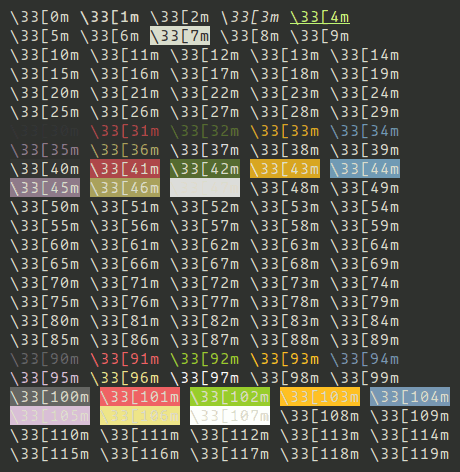


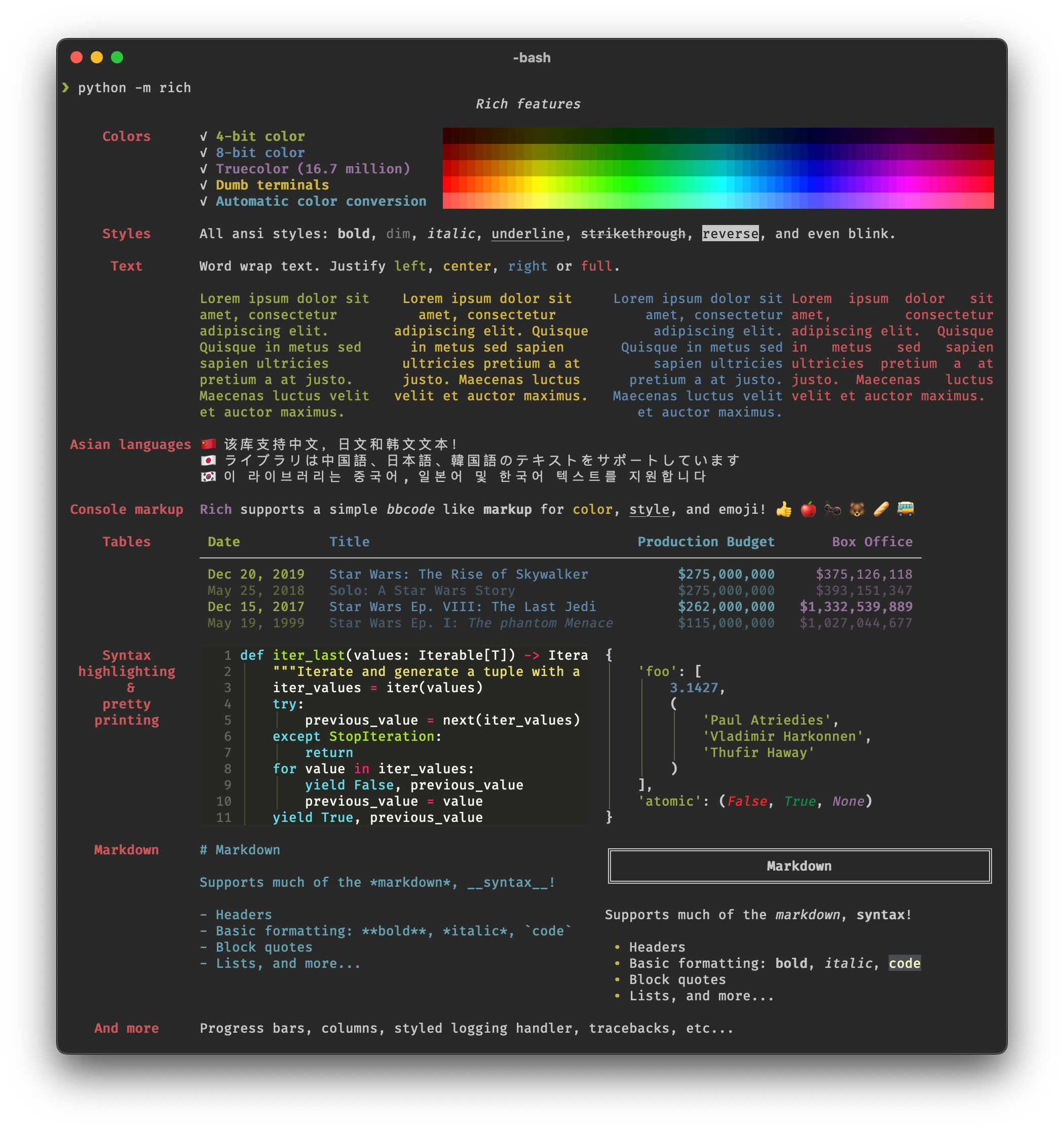
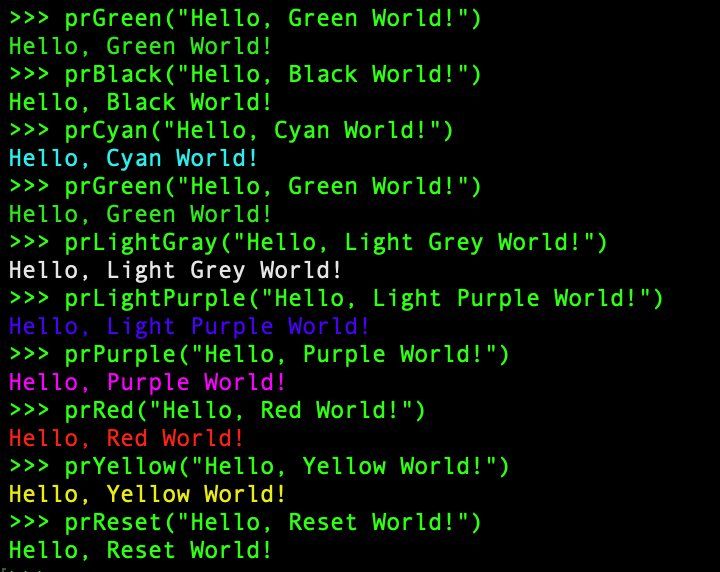
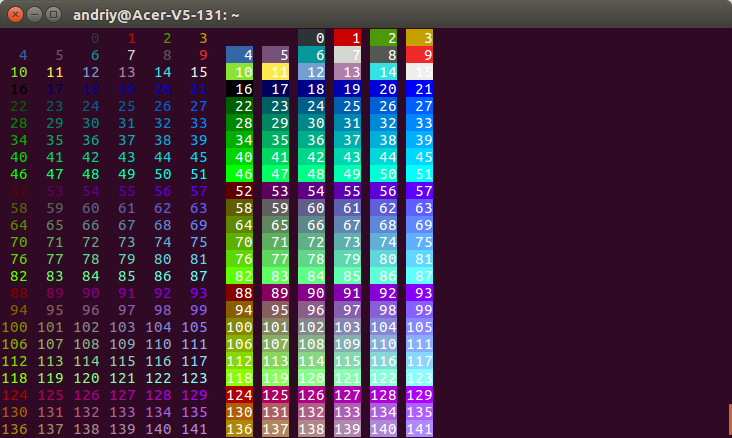

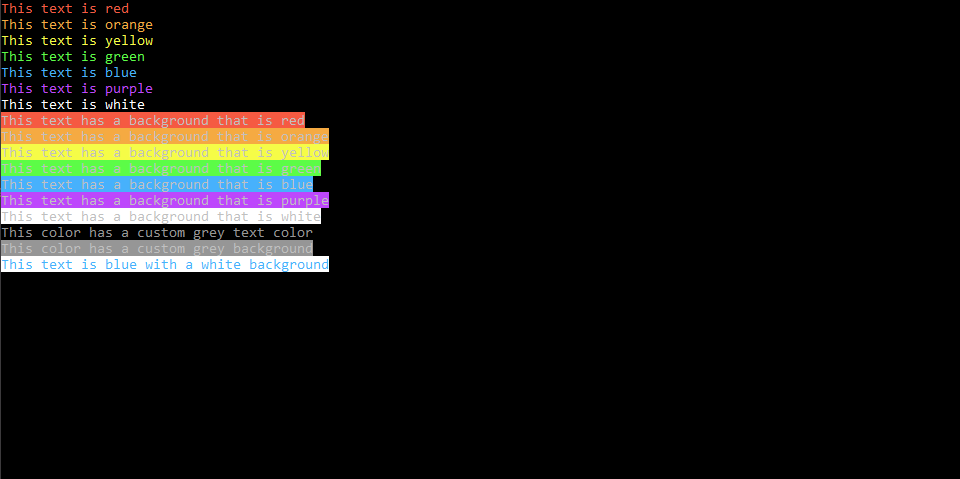

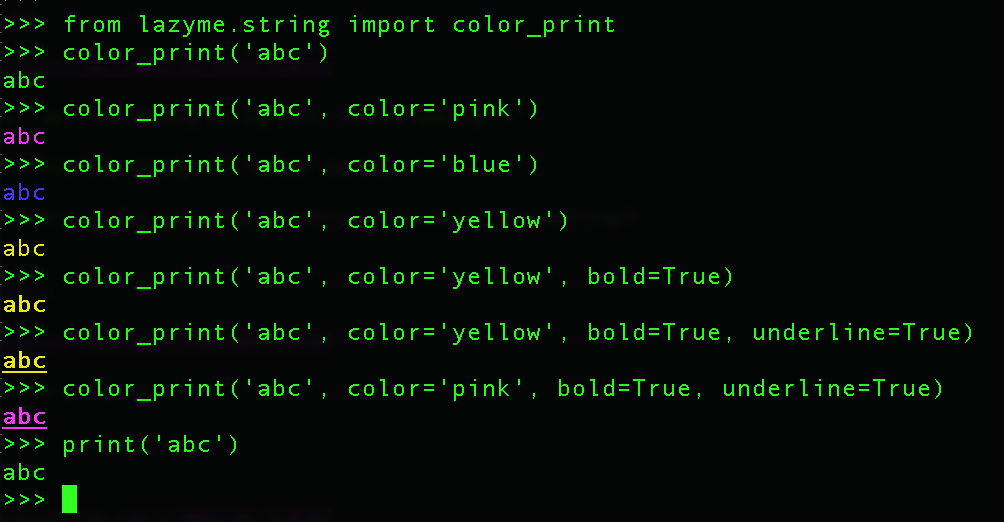
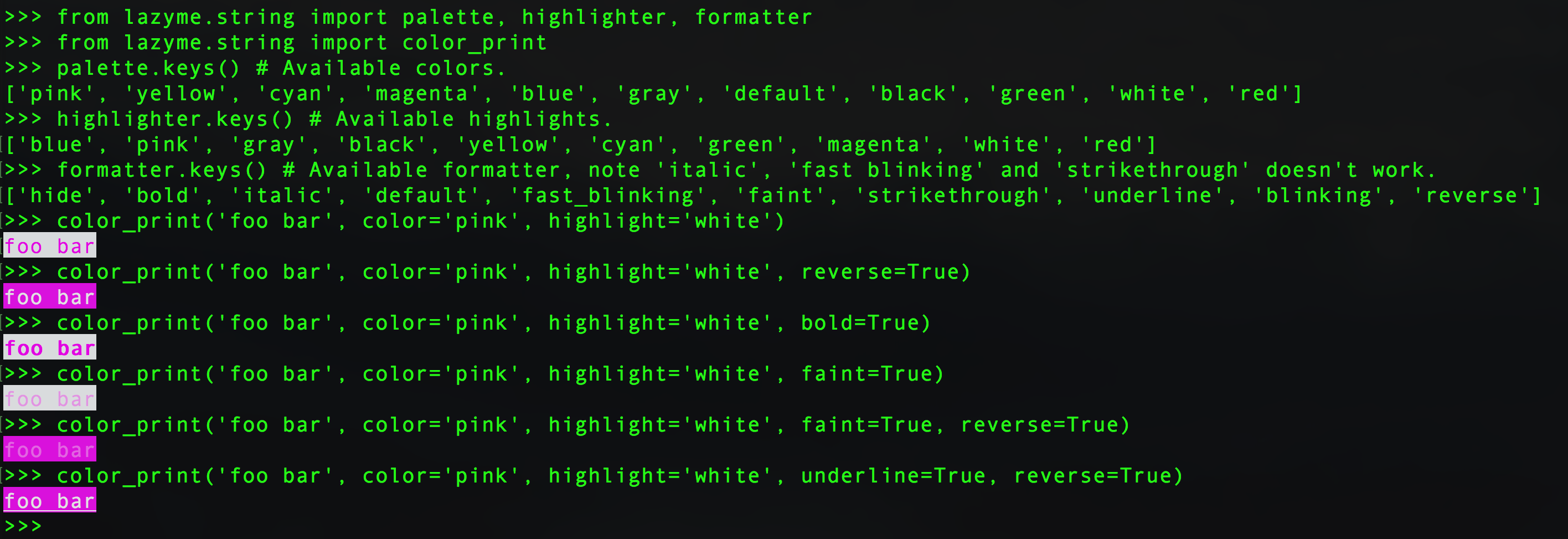
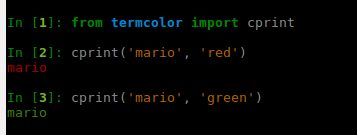




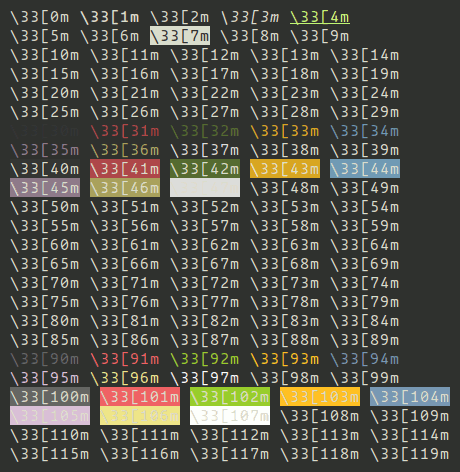









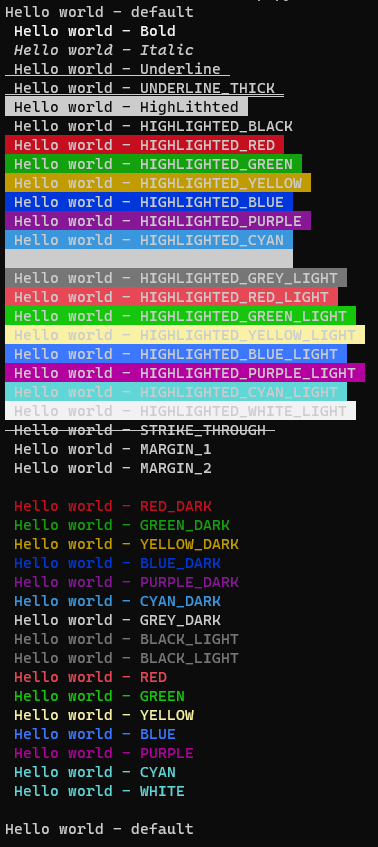

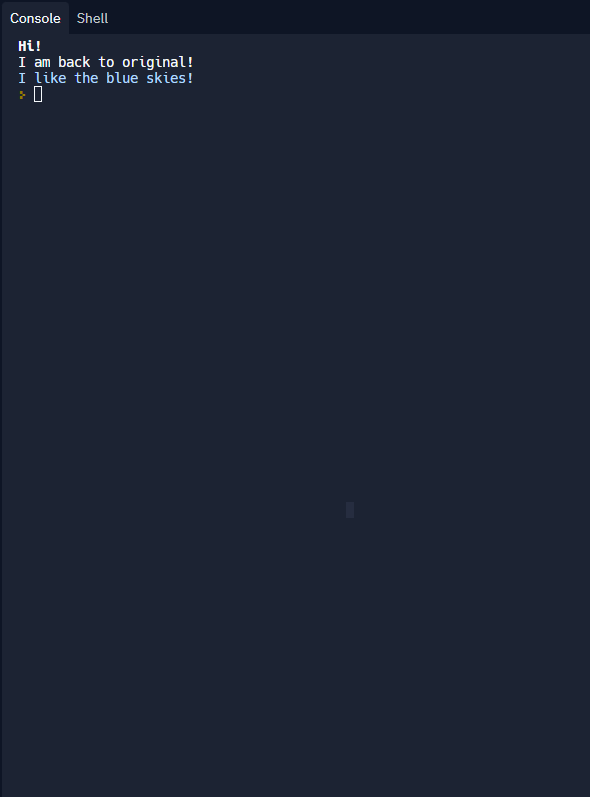






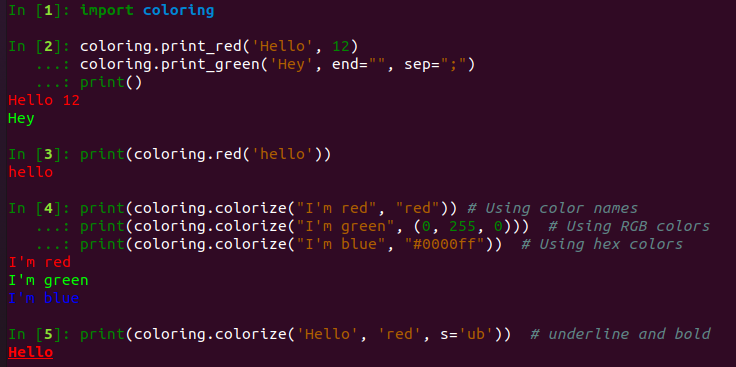

█Only problem is that it is extended ASCII, maybe you could get it to work usinghttp://stackoverflow.com/questions/8465226/using-extended-ascii-codes-with-python– Hitchpip install python-colored-printcolored-print – Lilalilac